À La Recherche du [cinq] Temps Perdu
Few composers appear to suffer from terminal rhythmic rigidity to the extent of Johannes Brahms, but as is so often the case, this is due to a miscreant notation that purloins the fact that Brahms was rapidly approaching a modern rhythmic sensibility.
Brahms' attraction to "5", as in five-bar or five-beat phrases, is well known, but while such phrases are not unknown before Brahms, their use tends to be entirely different from that of Brahms. The earlier use can be thought of as syntactical — the composer lengthens or shortens a phrase for whatever reason, even if only for variety, or to escape the boundaries of the binary. Brahms' viewpoint is generally quite different and can be thought of as prosodic — he finds "5" attractive not just because it provides variety, but because "5", owing to the plasticity of its components, allows him to engineer a conflict between the length of the phrase, and its internal metric.1
If one were to classify how Brahms uses "5", I would, as a preliminary, posit three primary types, although these rarely occur in pure form, but rather as combinations.
The first type allows Brahms to distort a metric pattern so that the number of feet remain constant, but the components either slow down or speed up, thereby creating a feeling of temporal flux. The last movement of the Second Symphony (measures 405 - 416), provides a prime example (ex. 1).

In this passage one frequently hears Brahms at his most turgid and stolid, with every binary beat being bopped, but there is a much more interesting solution (ex. 2). The melodic trajectory of the running eighth-notes starting at measure 405 - 408, quite clearly groups into three units of ![]() (the third unit is elongated). The four-bar phrase (measures 405 - 408) therefore contains three pulses, the first two of length -5-, followed by a longer last pulse of -6-, and this pattern is repeated (measures 409 - 412).
(the third unit is elongated). The four-bar phrase (measures 405 - 408) therefore contains three pulses, the first two of length -5-, followed by a longer last pulse of -6-, and this pattern is repeated (measures 409 - 412).

By abandoning the ![]() (measures 413 - 416), Brahms preserves the three pulses, now with values 4 + 4 + 8 [6 +2] within the same total duration of four-bars, while also creating a feeling of moving forward, due to the first two pulses of measures 413 - 416 being closer to one another.
(measures 413 - 416), Brahms preserves the three pulses, now with values 4 + 4 + 8 [6 +2] within the same total duration of four-bars, while also creating a feeling of moving forward, due to the first two pulses of measures 413 - 416 being closer to one another.
In (ex. 2) Brahms preserved the total duration but changed the internal metric. It is just as likely for him to preserve the metric, but destroy the total duration, and yet still provide a change of rate. Measures 333 - 340 (ex. 3) of the same movement and work partition (at almost the Golden Section) an eight-bar phrase into a five-bar, followed by a three-bar, phrase.

The first five bars have four units each of ![]() length (note the conflicting articulation, where the winds, which have the same material here as in (ex. 1) and (ex. 2), are in this instance slurred with the bar, and against the
length (note the conflicting articulation, where the winds, which have the same material here as in (ex. 1) and (ex. 2), are in this instance slurred with the bar, and against the ![]() of the strings). The next three bars still have four units each, but of
of the strings). The next three bars still have four units each, but of ![]() length, thereby speeding up the metric while preserving four pulses. It is in manipulations such as these that Brahms foreshadows metric modulation, and/or the use of similar rhythmic patterns at (simultaneously) different tempi.
length, thereby speeding up the metric while preserving four pulses. It is in manipulations such as these that Brahms foreshadows metric modulation, and/or the use of similar rhythmic patterns at (simultaneously) different tempi.
A second type of Brahms' use of "5" provides plasticity within a phrase. There are probably hundreds of such examples — i.e. the Violin Concerto, opus 77, first movement, measures 304 - 308, and any other place in that movement with the same motive; or in Symphony number 4, opus 98 (measures 45 - 52), which I would interpret as in (ex. 4),
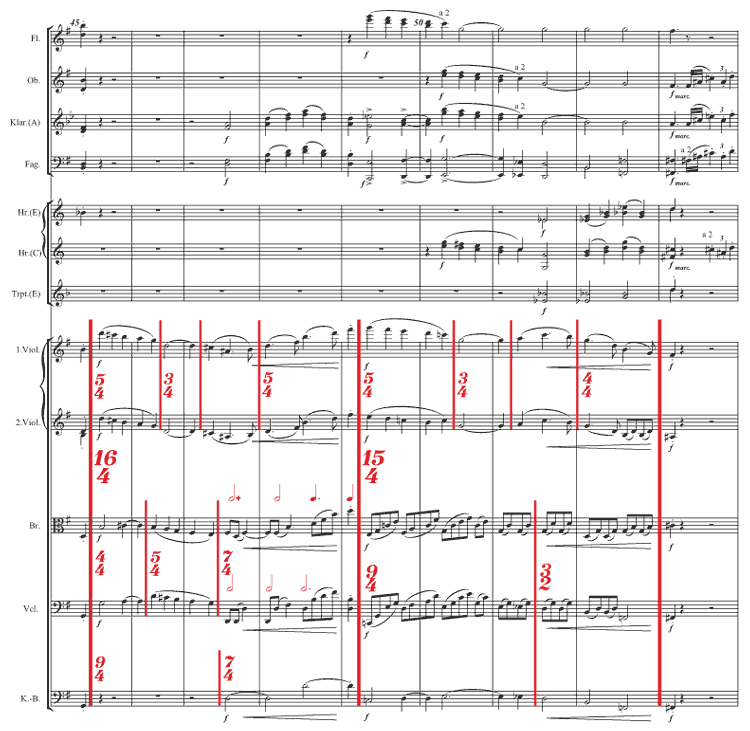
but a truly delicious double example in retrograde rhythmic counterpoint may be found starting at bar 57 (ex. 5).
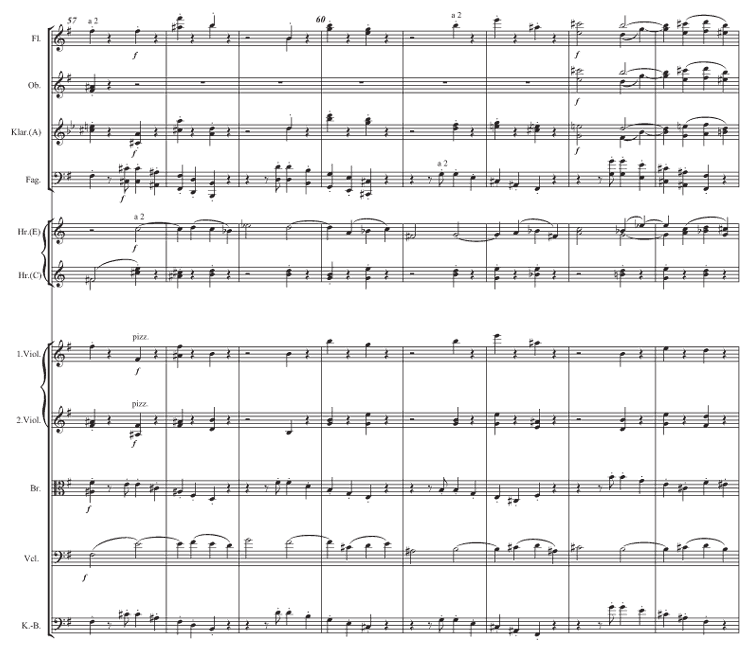
If one consults the manuscript (ex. 6) one finds (in the "tune") that the half-note tied to a quarter-note does not exist, but rather is notated as a dotted half-note with the dot placed at some distance,2 and this shorthand notation (if that is what it is) is from a composer who knew how to tie one note to another, and in other places in this very work, did so.
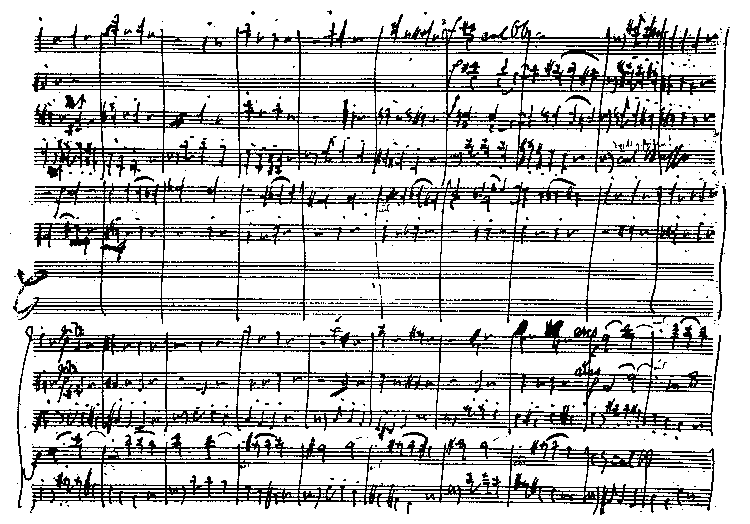
To my mind, the notation, far from being a shorthand, visibly implies that the two-bar phrase is to be thought of, and played, as 2 + 3 + 3, or 5 + 3, a not uncommon Viennese division of 8. Suddenly, there is a frolic to the phrase that is missing completely if the accentuation is the typical cloddish binary.
But there is more: Consider the doltish counterpoint in the Bassoons, Violas and Doublebasses, and if only to be an irritant, allow me to attempt to apply to that counterpoint the 2 + 3 + 3 metric of the "tune" (see ex. 7).
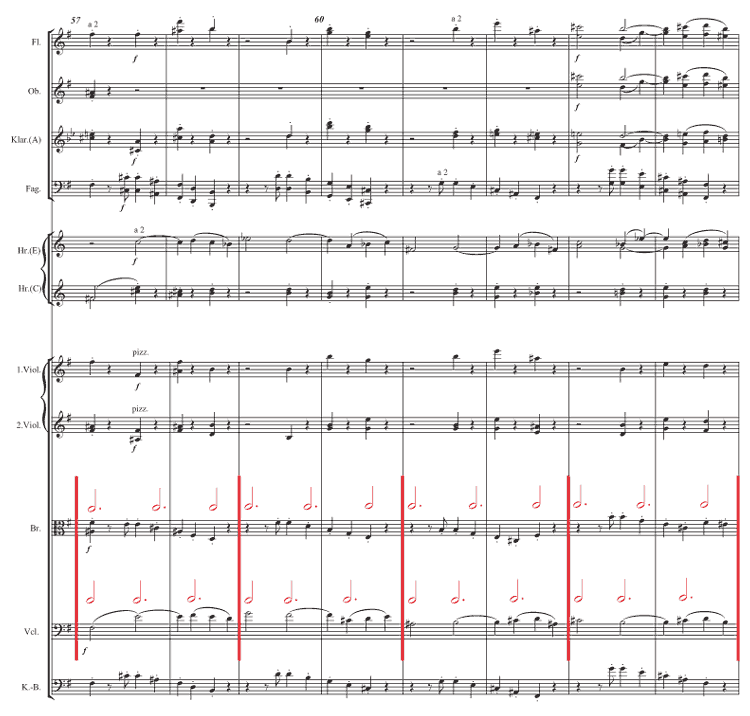
If I impose this metric reading forward the results are not impressive — i.e. one gains little either harmonically or rhythmically; but what happens if we reverse the pattern (3 + 3 + 2)? To begin with we add rhythmic pulses in places previously not represented in either the "tune," or in the displaced rhythm of the flutes, clarinets and pizzicati violins; but far more importantly, we emphasize an ascending pattern of seconds [A#-B; B-C#; (E-F#) x 2] which, when taken in temporal combination with the seconds of the "tune" [F#-E; G-F#; A#-B; C#-B] produce an intervallic variant of the opening theme!! In short, not only does the retrograde application of the metric make the passage more rhythmically interesting, but it reveals how the passage is related to the very germ of the movement, and entire Symphony.
I provide two examples of the third type of Brahms' use of "5." Here Brahms views "5" as a duration-field which provides him far greater options (than the binary or ternary) for parsing total duration. Ex. 8 is the opening of the Violin and Piano Sonata, opus 100.
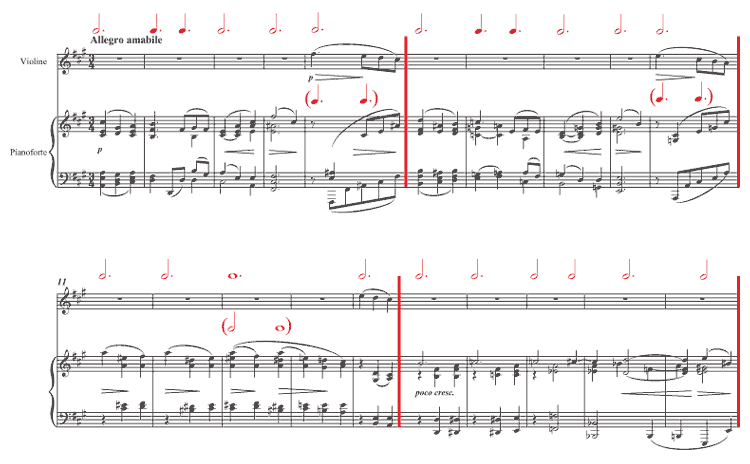
The first 30 bars3 of the work consist of six five-bar phrases, but it is the metric within these 5 phrases that piques our interest. As indicated by the superimposed values, the first, second, and fourth phrases, have 6 feet each.4 Yet another example of one foot more than the number of bar-lines occurs (in the same movement) at measures 31-34 (also not shown here) where, in four-bars, there are 5 feet.
While (ex. 8) demonstrates instances where there are more feet than barlines, (ex. 9) (Rhapsodie, opus 119) provides five-bar phrases with only 4 feet, in a fashion so blatant there is no need to discuss it.

As regards Brahms' rhythmic plasticity the above sketch hardly penetrates the surface, and I make no claim that the three types I have described above are all that exist. In closing, I must however make two points. The first of these is that, to my mind, Brahms' use of rhythm manifests a sensibility closer to that of composers of the 20th century, or at the least, from a contemporary rhythmic perspective, it is easier to feel a congruence with Brahms' rhythmic concerns than with those of earlier classical composers. Whether this is due to Brahms being prescient, or due to older compositional models held in common (the early polyphonists), or both, is neither important or germane. It suffices to know that the link between Brahms and today exists, and that link must be kept in mind, and emphasized, if we are to truly love Brahms (aimez-vous Brahms?).
My final point is rather less clarion - viz: when one performs, and/or hears Brahms performed in a fashion that takes into account what I have discussed above, the composer that emerges is not the usual bombast but rather one far more subtle, and far more complex who, in his intricacy, pacing, and perfume, almost approaches the Proustian. As I wish to strongly propose this thesis, perhaps I may be forgiven the egregious pun in the title of this note.
Paul Zukofsky
Originally published (in French) in
Ostinato rigore: revue internationale d'etudes musicales
Issue No. 10, 1997
Musical examples revised in June, 2004
Footnotes
- In the interest of full disclosure, much of my thinking is due to an amalgam between my father's (Louis Zukofsky) concern for metric versus line length; the opportunity for me to revisit Greek (and other) prosody because of Messiaen's Traité de Rythme, de Couleur, et d'Ornithologie; and from performing and recording Milton Babbitt, whose rhythmic motives are temporally scaled to different speeds, and originate at any point in time, thereby rendering the bar-line irrelevant.
None of these three worthies, however, are to be blamed for my flights of 'pataphysics. - Given the faintness of the slur and the difference in shape, I assume the slur was placed later, perhaps by a copyist.
- The example omits the last 10 bars.
- You may find the first of these forms in Messiaen, op.cit. I/94, example B, Forme II, b) 9; one must add a dot to each of the Messiaen values in order to compensate.
Brahms Examples
- 2nd Symphony, last movement, 405 - 416. Unmarked score.
- 2nd Symphony, last movement, 405 - 416. Marked score.
- 2nd Symphony, last movement, 333 - 340. Marked score.
- Symphony 4, first movement, 45 - 52. Marked score.
- Symphony 4, first movement, 57 - . Unmarked score.
- Symphony 4, first movement, 57 - . Facsimile of original.
- Symphony 4, first movement, 57 - . Marked Score.
- Violin Sonata, opus 100, first movement, 1 - 34. Unmarked score.
- Rhapsodie, opus 119, first page. Unmarked score.